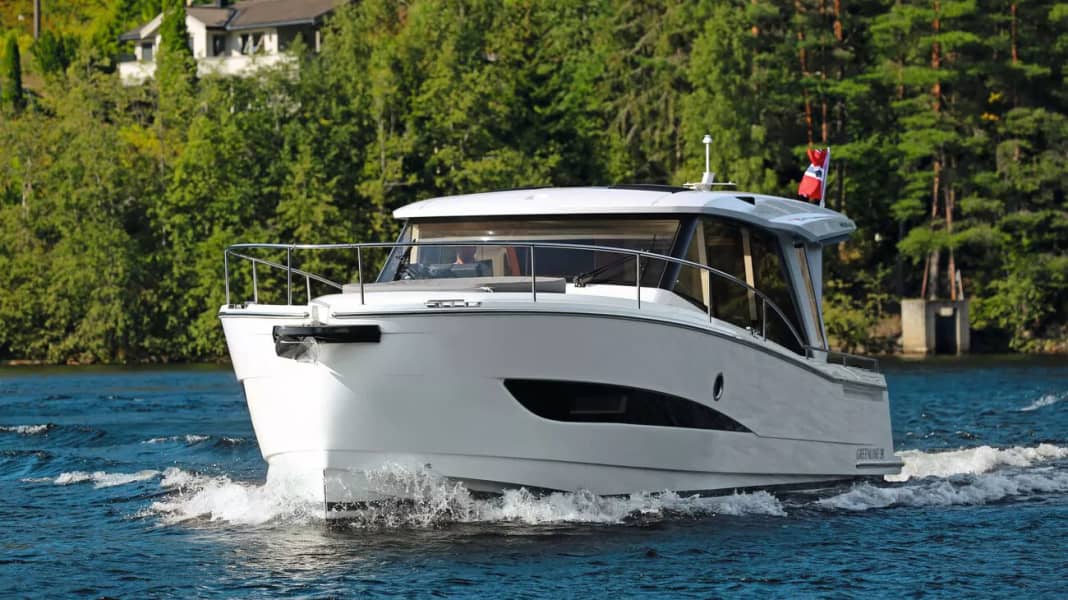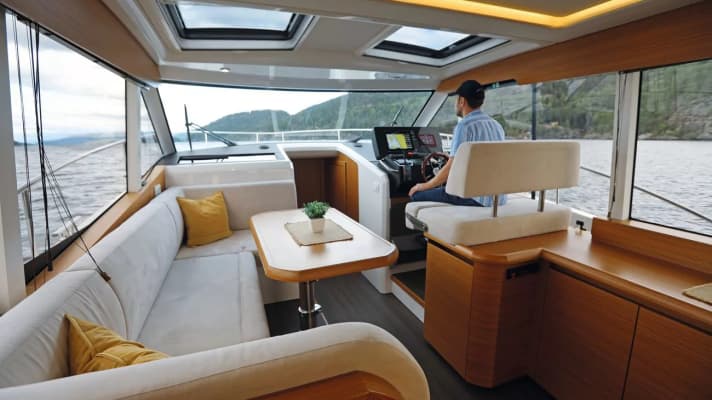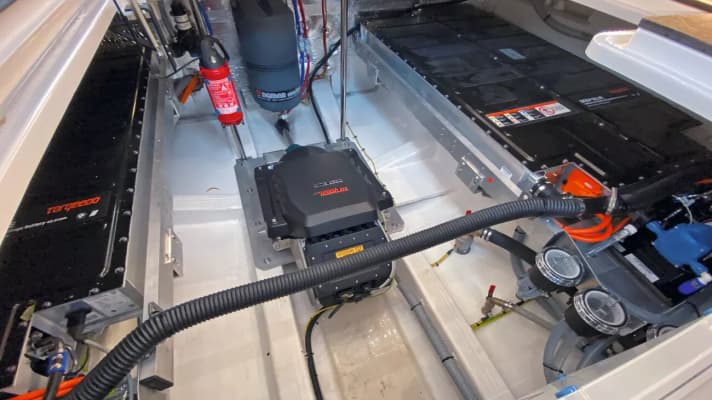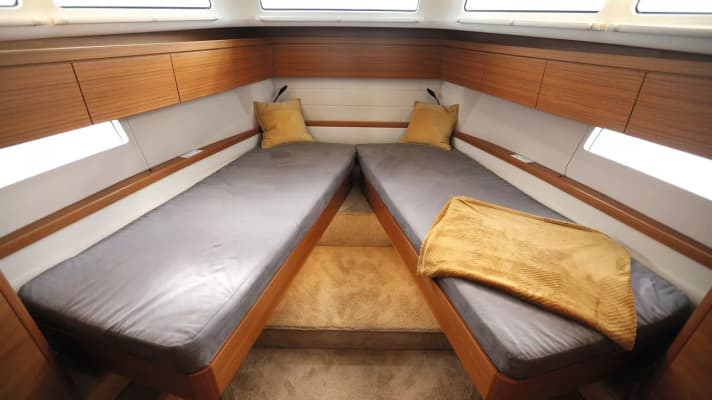
The concept is a familiar one: the engine of our test Greenline 39 is powered by a battery instead of a fuel tank. It is a purely electric boat. We already know the feeling from outboards on small boats when the throttle is turned up and the boat starts moving as if by magic. Electric mobility on the water is a great experience.
But when, after a quick handover and briefing ("That's the on button. That's it"), the lines of the seven-tonne and extremely voluminous Greenline 39 are cast off, panic briefly breaks out in our heads. The reassuring rumble of the 4-cylinder engine is simply missing. The mind automatically switches to alarm and possible consequences: Engine failure, the ship is about to start drifting in the current of the river. But we manage to suppress the first instinct and push the throttle forwards instead. All of a sudden, a quiet whirring starts under the stern of the boat. The Greenline picks up speed. Two knots, then three. We leave our box and head up the river that leads from Porsgrunn in Norway to the start of the Telemark Canal - the usual route of the Greenline 39, which was specially developed by the shipyard in Slovenia as an all-electric version for use as a charter boat. And here in Porsgrunn is the very first all-electric charter boat fleet in Europe.

Purely electric. A concept that could not be realised anywhere else before, because the network of charging facilities is nowhere as well developed as here in Norway. What's more, the canal is perfect for this: a picturesque area that you want to explore at a leisurely pace anyway, i.e. at six knots. Norway also generates well over 90 per cent of its electricity from hydroelectric power stations. As a result, the flowing waters are not only explored by our Greenline 39, but in a figurative sense even drive it.
But this is only in passing, because after the travel report (BOOTE 11/21), the test will be about the boat.
Before the charter fleet was established, Greenline only built boats that were powered by a diesel engine or a hybrid system, the latter with a 14 kW electric motor mounted between the diesel engine and gearbox. This allowed the boat to cover shorter distances at a comfortable speed using electric power. However, Greenline had to develop a new concept to be able to drive purely electrically and cover the necessary distances.
The boat
- Shipyard: Greenline Yachts/Slovenia
- Type:39 E-Drive
- CE category: B (10 persons)
- Hull and deck: plastic
- Overall length: 11.99 m
- Width: 3.75 m
- Draught: 0.90 m
- Displacement: approx. 7000 kg
- Clearance height: 3.40 m
- Water tank: 400 litres
- Holding tank: 80 litres
- Berths: 4+2
- Berth dimensions at the front: 2.00 x 0.80/1.60 m
- Berth dimensions centre: 2.00 x 0.75 m
- Standing height/seat height: forward cabin 1.87 m/1.14 m; centre cabin 1.86/0.64-0.45 m; WC compartment 1.82 m
- Cockpit size: 1.70 m x 3.15 m
- Sunbeds: Foredeck 1.98 m x 1.48 m
- Freeboard: 1.10 m
- Interior cockpit side height: 0.67 m
- Side deck width: 0.14 m (BB)/0.40 m (SB)
- Turning circles (boat lengths): forwards starboard 1.5, port 1.5; astern starboard 2, port 2
- Reversing from starboard to port: not possible
- Reversing from port to starboard: not possible
- max. motorisation: inboard engine 272 kW (370 hp)
- Test motorisation: 1x Torqeedo Deep Blue 80i 1400, 66 kW (80 hp)
- Battery: 2x Torqeedo Deep Blue 40 kWh
- Price (standard boat with test engine): €551,300
- Shipyard: Greenline Yachts, Begunje, Slovenia, www.greenlinehybrid.com
Our Greenline 39 E-Drive therefore has a 50 kW electric motor from Torqeedo (Deep Blue 80i) with shaft drive and two 40 kWh lithium-ion batteries, which actually come from BMW, instead of the hybrid motor. The powerful battery banks give the boat a range of just over 30 nautical miles at a cruising speed of six knots. At the maximum speed of 8.9 knots (according to our test), the range shrinks to just twelve nautical miles. According to the shipyard, the maximum speed of the boat without the typical load of a charter boat is even eleven knots. In other words, the crew can either sail at six knots for five hours with full batteries - or at eleven knots for one hour. Then the 80 kWh battery is empty.
At the end of each day's stage along the canal route, there is the option of recharging the batteries using a Quickcharger (63 A). If the battery is completely empty, it only takes 3.5 hours to fully charge it. The amount of electronics required for this on the test boat is still immense: a total of nine chargers are required, which are mounted under the aft deck. In terms of background noise, the cooling fan is in no way inferior to a leaf blower. Outside of Norway, however, such an extensive charging network is unlikely to be found. For this reason, it is even possible to charge the Greenline 39 with adapters at any 16 A bar or Schuko socket, although this takes a good 13.5 hours.
The motor
- Manufacturer: Torqeedo
- Type: Deep Blue 80i 1400
- Power: 66 kW/80 hp
- Full load speed: 1,400 rpm
- Torque: 343 Nm
- Fuel: Battery
- Cooling: Water, 7 litres/minute
- Weight: 80 kg
Using such a complex boat as a charter boat is a courageous undertaking, as the skipper needs some experience to be able to sail safely with such a manageable range (compared to the diesel version with a 700-litre tank). The charge status and range of the boat are constantly shown on the display - but if the skipper miscalculates due to too much throttle or a strong headwind on a leg and does not reach his destination, there is no "plan B" on our charter boat. No hidden switch for a battery reserve or a generator. Unlike an electric car, the boat would not simply stop, but would start to drift. The boatyard now offers a small 4 kW generator as a "range extender".

The cabin of the Greenline 39 is more than cosy. The large windows offer a panoramic all-round view, light-coloured surfaces and upholstery contrast with dark woods. As an electric boat, the galley has of course also been fitted with an induction hob and an electric oven.
A deep-pile carpet in the sleeping cabins creates a cosy feeling. In the forward cabin, two single beds can be pushed together to form a large double bed. Although the midship cabin has sufficiently large beds, the headroom is only 64 and 45 centimetres respectively due to the saloon floor above, making the feeling of space there a little oppressive and making it more suitable as a "sleeping cave" for children.

The handling characteristics are ideal for canal and coastal cruising and the boat is very stable. At cruising speed (six knots) the driving noise is very quiet, but at full speed the engine noise is hardly any different from that of a diesel. The bow and stern thrusters are really necessary for manoeuvring, as the steering hardly reacts at all in reverse. The rudder blade would probably need to be somewhat larger for this. The Greenline also requires a minimum speed of three knots. Below that, it starts to drift even in light crosswinds due to its high superstructure and small lateral surface.
Conclusion
The Greenline 39 E-Drive impresses as a fully-fledged, well thought-out electric cruising boat with a well-dimensioned battery capacity and range. Even if the charging network is nowhere as well developed as in Norway, the charging options with the marinas (16 or 32 A) are completely sufficient to operate the Greenline elsewhere. The living space is modern and of high quality, and the space is ideal for a family of four. Thanks to the integrated solar panels on the superstructure, the Greenline 39 is also self-sufficient at anchor for longer periods and is a big step towards sustainable boating.
You can find the test of the Greenline 39 E-Drive in BOOTE issue 08/2022 from 13 July 2022 at newsstands, online directly in the Delius Klasing Shop - and already here.

